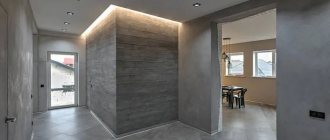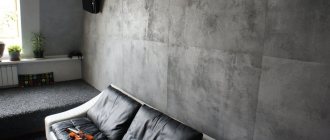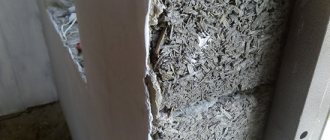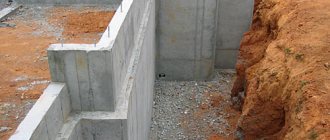Decorative plaster compositions with imitation of various surfaces are not only a building material, but also modern technologies. One of the most common types of finishing of interiors and even facades is decorative plaster for concrete. The article outlines options for stylizing the surface as concrete, a description of mixtures and additional components, and the basics of the technological process. Knowledge of the characteristics of the material and its application technologies will help to properly organize and control the finishing process.
Proper finishing of the wall “like concrete” looks very modern Source oikos.by
Decorating the surface for concrete
Plaster that imitates the surface of concrete has become a popular type of decoration for rooms in the minimalist style. Walls with a “concrete effect” look durable, solid, monumental, even if they are built from plasterboard.
Users are attracted not only by the illusion of strength and reliability, but also by the minimalism of appearance. Plastered in this way, the wall imitates the surface before the renovation began. But when looking at her, there is no feeling of incompleteness.
Decorative plaster for concrete in the interior in this style is usually performed in rooms with a simplified, at first glance, general design.
Types of material
Concrete plaster can be made from different types of mixtures. To understand which option is better to choose, you should understand the features of each type. The following plasters can be used to achieve the concrete effect:
- Microconcrete, it is based on cement; in addition, quartz chips, pigments and polymer substances are used in the composition. The products are distinguished by their hygroscopic properties, plasticity, heat resistance, and also do not absorb odors;
- Microcement is a cement base with a polymer mixture. There are no quartz chips in its constituent components. Can be selected for coating ceramics, metal, wood, plastic, concrete.
In addition, there is a division of compositions into the following types:
- Textured, a base with roughness is obtained;
- Structural, different in obtaining a relief surface with irregularities;
- Venetian, what stands out is the production of a glossy, smooth base, which is as similar as possible to concrete.
They differ in the fractions that are used to obtain a certain texture. They can be larger or smaller in size.
Concrete plaster can be made from different types of mixtures.
Matching style
A minimum of things, furniture, muted colors, and discreet decor are generally called high-tech style. Premises decorated in this way can be used as a club or restaurant, as a rock studio or creative workshop, as a formal office space or as the home of a person who understands and loves art.
But there are no strict rules for home design. Therefore, in some cases it is advisable to install a bright sofa in the room or decorate one of the walls with abundant living greenery or flowers. Lighting is important, because twilight in a home with “concrete” walls causes a negative mood.
Without good lighting, such a room will look gloomy Source zebra100.ru
It is recommended to design concrete-look walls in rooms with high ceilings, preferably in large areas. A large space with bright lighting is associated with the naturalness of the loft style.
Composition of the plaster mixture
Manufacturers offer ready-made plaster mixtures in various versions. Conventionally, they can be divided into two groups: microcement and microconcrete. Both categories contain:
- Finely ground cement;
- Seeded sand of minimum fraction, cleared of impurities;
- Polymer additives that give the compositions specific properties.
In addition to the listed components, microconcrete contains mineral additives of a slightly larger fraction.
The ingredients are usually indicated on the packaging. The manufacturer's recommendations, rules for preparing the surface, mixing the mixture and applying plaster are also written there.
Examples of wall textures “like concrete” Source o-remonte.com
See also: Catalog of companies that specialize in finishing materials.
Application technology
Puttying of concrete walls is carried out in several stages:
- Treatment of concrete base. First of all, we remove the old coating (or its remains). We widen the existing cracks with an electric drill until the concrete breaks off easily. We remove dust, dirt, oil stains and other foreign substances from the surface. Using cement mortar, we repair defects in the floor or walls, and then wait for the surface to dry.
- Priming a concrete structure. Clean the surface again. Consistently apply two layers of primer. At the same time, before each next stage, we wait until the primer is completely dry.
- Mixing the solution. The putty composition is prepared according to the recipe specified by the manufacturer on the packaging. The optimal proportion of powder is considered to be 1/5 part in relation to water. The solution can be used within 3-5 hours after the end of the batch. The method of stirring largely depends on the available volume of putty. A small container can be handled with a standard mixer, but to mix 25 kg or more you will need a concrete mixer. When stirring, avoid introducing excessive air into the solution.
- Puttying. Pour the solution onto the surface and spread it with a spatula. To increase the strength of the surface, we use reinforcing mesh. We wait for the first layer to dry and apply an additional amount of material. The final hardening of the coating occurs after about a day (or even more - the period depends on the depth of the defects).
- The final stage is removing small irregularities using sandpaper.
Advice! It is recommended to pay attention to the manufacturer's recommendations regarding putty consumption per square meter of concrete surface at a certain layer thickness. This will optimize material costs.
Putty is an excellent tool to protect concrete and facilitate further finishing work. It is recommended to carefully study the characteristics of the mixture in advance in order to select the appropriate composition for specific operating conditions.
Properties and advantages of plaster
In addition to its appearance, which can be combined with any materials in the interior, decorative plaster “concrete” has a number of positive characteristics. The list of advantageous properties that allow us to consider the material universal and accessible in use:
- does not respond even to significant changes in humidity and air temperature in the room;
- does not require regular care;
- the plaster layer performs the function of retaining heat in the room, allowing you to significantly reduce heating costs;
- does not exert additional load or other undesirable effects on the original surface;
- easy to paint with any composition;
- can be used for an extremely long time without changing properties;
- applied to any surface with a high degree of adhesion;
- does not require high-quality smoothing or grinding;
- allows the use of stencils and stamps;
- work on applying plaster does not require high professional training;
- the surface texture is selected at the user’s request;
- Surface shades can be varied by adding regular acrylic dyes.
The addition of dyes makes the plaster more beautiful Source beton-house.com
Requirements for putty
Concrete structures are constantly exposed to mechanical stress, the destructive effects of moisture, as well as various chemicals for cleaning surfaces. This is especially true for floors. Therefore, when choosing a putty, special attention should be paid to its pros and cons.
Use a spatula and scoop up the finished putty.
If you want the walls and floors of your home to be reliably protected and carefully leveled, the product you choose should have the following advantages:
- strength;
- good adhesion properties;
- not exposed to water and moisture;
- safety;
- resistance to external influences;
- durability.
One of the common disadvantages for all types of putty is its inability to glue the covering layers of the concrete coating to the substrate. Most often, putties are applied to the primer. In addition, the disadvantages of this material are the following qualities:
- elimination of defects and irregularities of only a minimal size;
- finishing requires special skills;
- If flooded, the putty surface will still suffer.
To reduce the negative consequences, you need to figure out which remedy is the best?
Disadvantages of exclusive plaster options
Plaster has practically no disadvantages. In technological terms, some difficulties may be caused by the length of time the mixture hardens. But this indicator is not critical - it is somewhat worse from the economic side of the issue.
Creating exclusive interiors requires not only the cost of expensive raw materials, but also payment for design development and selection of individual mixture components.
Good design is far from the cheapest pleasure Source market.kz
Peculiarities
When choosing a composition, you should take into account the individual characteristics of not only the room being decorated, but also the concrete plaster itself in the interior:
- The structure of the plaster is porous and the surface is rough, this is caused by the content of mineral fillers and additives in it;
- The relief of the coating is achieved by sequentially applying several layers of the mixture;
- Preliminary preparation of the surface to be plastered consists of cleaning it from dust, dirt, and previous coatings;
- During work, you should use personal protective equipment, since the mixtures contain polymers that are harmful to health.
An example of combining plaster and other finishes Source connexionav.com
How to apply decorative coating
Plastering the surface must be done on a prepared base. The old finish is removed from the walls, and all types of contaminants are also washed off so that adhesion is better. Priming is carried out; when the layer is completely dry, you can proceed to applying the plaster solution:
- The first step is to make a base layer using a spatula, which will be smooth; it must dry.
- Move on to the 2nd layer, which is also applied, creating the required layer thickness.
- Without waiting for it to dry, you need to have time to create drawings on the wet layer; a broom is suitable for this, which is applied perpendicularly with twigs and removed, as a result you get unusual marks.
- When the entire wall has been treated and the composition has dried, the surface is sanded with sandpaper.
- Concrete-like paint for the walls is then applied.
Plastering the surface must be done on a prepared base.
Offers from the top 5 manufacturers
There are many manufacturers of decorative plaster, but only some of them are constantly engaged in monitoring and improving the quality of their products. As a rule, these are well-known manufacturers who value their reputation:
- Prof Decor . A company from Russia produces decorative building materials in a wide range. Suppliers of initial components for plaster mixtures have been selected for the company over the years - only the best cooperate with this manufacturer. The company is distinguished from other manufacturers by the widest selection of colors and shades of plaster.
- San Marco . Decorative mixtures from this manufacturer are purchased by users who are interested in increased strength, moisture resistance and other increased characteristics. Similar parameters are required for plastering surfaces in non-standard and extreme conditions. The variety and excellent quality of polymers in mixtures is the strong point of the Italian manufacturer.
- "Flex Concrete System" . Decorative concrete for walls under this brand is used for surfaces that have direct contact with moisture or are subject to frequent overheating and temperature changes. A distinctive feature of the company’s products is the exact imitation of natural materials.
Original finishing solution Source stroyres.net
How to make your coating even more impressive
To get a more perfect effect, it is possible to apply a varnish on top. There is a special wax on the construction market for this purpose that gives a more luxurious texture to the coating. Using it will help you get a shiny finish that will shine in the sun.
To get a more perfect effect, it is possible to apply a varnish on top.
Practical recommendations
When using the material, it is advisable to be guided by practical rules compiled by masters based on experience and mistakes made:
- Rooms where all the walls are covered with decorative plaster do not look very good. Art-concrete plaster in the interior is in perfect harmony with all finishing materials. Therefore, as a contrast or to highlight a special zone in the room, it is allowed, and sometimes it is simply necessary, to use wood, glass, or metal. The shape and layout depend on the taste of the owner or the conditions of the project.
Combination of materials in decoration Source archilovers.com
- The choice of color combinations depends on individual preferences, but harmony is paramount.
- Ceilings can be plastered in the same way as walls, but the shades of the ceiling plaster should be lighter.
- Sharp contrasts in the interior with “concrete” walls are acceptable, but in very small proportions.
Proper use of contrast and accents makes the interior recognizable and original Source id.aviarydecor.com
- Decorative plaster is not intended for leveling the surface to be coated, sealing cracks, joints and potholes.
Types of putties
Based on the nature of their use, putties are divided into three groups:
- Basic - used for application directly to a concrete surface.
- Finishing - used as a top layer, on which finishing work will be carried out in the future.
- Universal - can be used both as base and finishing.
Base mixtures
Starting (or base) putties are used at the very beginning of puttying, when you need to level the concrete surface. Such compositions are applied in as thick a layer as possible. Starting mixtures are most often produced in powder form. It is the fact that the base mixtures are offered in powder form that explains such great attention to the correct preparation of the finished composition. The final product should have elasticity and not be too thick or runny.
As a rule, one coat is not enough to create a reliable starting coating. When the first layer dries, the coating must be sanded and then additional layers must be applied. As an example of a high-quality putty composition from this group, we can mention the “Starateli” brand.
Finishing mixtures
This group of mixtures is intended for the final processing of an already puttied coating. The task of the finishing composition is to make the surface as even and smooth as possible. The finishing mixture is applied in a thin layer, which is applied to the already polished concrete. An example of a high-quality putty is the Ceresit brand, which has a whole series of finishing grades for concrete.
Universal mixtures
The name eloquently suggests that putties of this group can be used for both initial and finishing treatment of concrete. However, any versatility is fraught with the loss of qualities inherent in specialized compounds. In addition, the cost of such mixtures is higher than that of specialized options. The most famous representative of the group of station wagons can be considered such a well-known brand as “Novol”.











